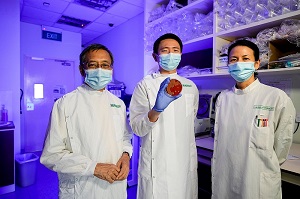
14 December 2021 - Singapore scientists have identified and named a new species of bacteria, Staphylococcus singaporensis sp.nov, named after Singapore. This newly-described pathogen is part of the Staphylococcus aureus (S. aureus) complex1. S. aureus is a common bacterial cause of infections. Infections range from skin and wound infections, surgical infections, to blood stream infections which may be fatal.
In a study published in the International Journal of Systematic and Evolutionary Microbiology on 26 October 2021, the research groups from the National University Hospital (NUH), National Centre for Infectious Diseases (NCID) and Singapore General Hospital (SGH) studied bacteria isolates which appeared related to S. aureus. A total of 43 isolates were included in the study between April 2019 and July 2019.
Whole genome sequencing of the isolates was performed and comparative genome analysis found that 6 isolates out of the 43 were quite different from other members of the S. aureus complex. In combination with comprehensive biochemical testing, these 6 isolates were confirmed as a new species. They were given the name Staphylococcus singaporensis (sin.ga.por.en’sis. N.L. masc. adj. singaporensis; named after Singapore) with isolate SS21T designated as the type strain.
S. singaporensis is closely related to S. aureus and will be identified as S. aureus using routine diagnostic tests. Whole genome sequencing is currently required to make the identification. The spectrum of disease caused by S. singaporensis will need to be further studied.
The 6 isolates found in the study came from skin and soft tissue infections, and one from the tube inserted after bile duct surgery. The isolates are susceptible to commonly-used antibiotics, unlike some S. aureus which have developed multi-drug resistance (termed "MRSA"). S. singaporensis also lacks many of the toxin genes frequently found in S. aureus. However, more data needs to be collected over time, both locally and globally, to fully understand the impact of the new species. Identifying a new species enables scientists to analyse and predict more precisely the outcomes of infections due to various species.
"The identification of this new species using the latest laboratory tools shows that our scientists in Singapore have the capability to investigate future emergence of new bacteria which may cause outbreaks or severe disease," said Associate Professor Raymond Lin, Head and Senior Consultant, Microbiology, Department of Laboratory Medicine, NUH and Director, National Public Health Laboratory, NCID.
Dr Chew Ka Lip, Consultant, Microbiology, Department of Laboratory Medicine, NUH explained, "There remains much to be done to understand the differences if any, between these organisms in terms of clinical infections and prognosis. This could potentially lead to more tailored clinical care management of our patients to optimise outcomes."
Dr Jeanette Teo, Principal Scientific Officer, Microbiology, Department of Laboratory Medicine, NUH added that, "Emerging technologies like next-generation sequencing bioinformatics analysis have facilitated new species discovery, without which this new finding would not have been possible."
Further research
Meanwhile, the scientists have made available the bacterial strains of the new species to the NUS Department of Microbiology and Immunology. All 6 isolates have also been deposited in international strain repositories. It is essential that future research encompasses clinical observation, as well as basic laboratory research. This will elucidate the basic biology of the new species, and establish the differences between S. singaporensis and S. aureus, as well as other staphylococcal species.
Related:
















